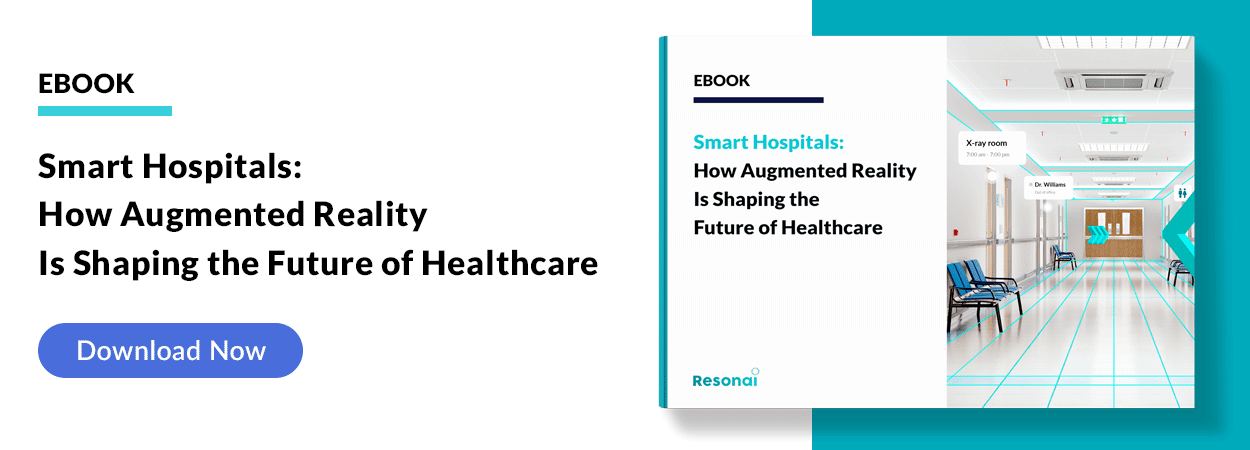5 Examples of Augmented Reality In Modern Healthcare Facilities
From navigation to education, hospitals benefit from these examples of augmented reality healthcare applications.
April 20, 2021

At one time, augmented reality (AR) was little more than science fiction. Today, it plays a major role in every industry — perhaps the most important being healthcare. Hospitals increasingly rely on AR solutions for surgical assistance, patient onboarding, and even practitioner education. In this article, we’ll explore these capabilities while highlighting practical examples of augmented reality in healthcare.
Jump to a section…
Augmented reality examples in healthcare
Defibrillator station wayfinding
IV assistance and vein detection
Augmented reality examples in healthcare
Doctor and patient education
One of the best examples of augmented reality in a healthcare setting is its use as an educational tool. With AR, doctors and professors can generate 3D representations of potential patients in university and college hospitals, taking the guesswork out of visualizations. Outside of medical students, AR has a patient education component as well — it can visualize the effects of medications and surgeries in ways that help laypeople understand medical processes.
HoloAnatomy is just one example of the advances in AR-powered medical education. This platform helps instructors visualize and represent any aspect of human anatomy, including the cardiovascular system, individual organs, and much more. Students can wear a HoloLens headset in a classroom setting as the instructor guides them through custom-designed 3D lectures, complete with visuals of human anatomy in different positions and scales.
Hospital navigation
Modern hospitals are complex facilities that both patients and new staff can find difficult to navigate. One useful AR function is designing navigation and wayfinding tools that help anyone orient themselves to the environment. When made accessible through a smartphone app, these tools are valuable to newcomers and relieve pressure on support staff.
Resonai’s healthcare AR solution accomplishes this through a virtual concierge — an app that can be used to offer personalized building navigation guidance and indoor wayfinding. On the patient level, this tool gives directions to requested departments and lets patients choose an ideal path. Resonai’s AR navigation can also account for foot traffic hot spots to help maintain social distancing practices. On the staff level, medical teams gain a complete overview of the facility to assist rapid response units in real-time.
Outside of standard navigation, AR has the potential to lend real-time assistance during emergency scenarios. When a fire, earthquake, or other disaster occurs, hospital staff may need to evacuate occupants as quickly as possible. A well-designed AR wayfinding solution can direct occupants to exits on paths that avoid danger zones and prevent overcrowding.
Defibrillator station wayfinding
Navigation and wayfinding are excellent uses for augmented reality in healthcare, but directions can also be helpful for local orientation. Many hospitals install defibrillator stations at key locations for access during an emergency outside of traditional med units. With the right AR tools, anyone with a smartphone can pull up directions to these defibrillators from an app interface.
Lucien Engelen built one example — AED4EU — for the Radboud University Nijmegen Medical Centre in the Netherlands. This app lets users mark external defibrillators and AED units within a database that users can access from their smartphones. By combining AED4EU with the Layar browser, an AR function can quickly locate and display the nearest AED. While this specific app focuses on defibrillators, future iterations can apply the principle to any kind of medical equipment or apparatus.
Intravenous assistance and vein detection
A wide variety of medical treatments are administered intravenously, but an estimated 7 to 21% of first attempts to find a vein will fail, even when carried out by medical professionals. Inserting an IV takes training and practice, but AR can help nurses and technicians become more effective in the moment.
AccuVein is a handheld scanner that leverages AR technology to make IV insertion far easier for everyone involved — especially patients. The device projects an overlay directly onto the patient’s arm to show vein pathways that nurses can mark accordingly. AccuVein boasts that its scanner increases the likelihood of finding a vein on the first attempt by 3.5x, freeing hospital staff to focus on other patient needs.
Smart hospital automation
Smart buildings are facilities that use integrated technology systems to increase efficiencies and assist occupants with daily operations. They are most common in commercial spaces, but healthcare organizations are starting to see the value of “smart hospitals” that extend the principle to medical equipment. When these devices are linked, facility managers can automate building functions, manage control systems remotely, optimize energy use, and significantly reduce operational costs.
Cortellucci Vaughan Hospital in Ontario, Canada, is a smart hospital that launched in 2021. This facility uses seventy-five smart workflows to improve staff efficiency and provide caregivers with more time to assist patients. For example, Cortellucci Vaughan’s rapid response team wears real-time location badges that override elevator systems to give them priority. Meanwhile, when the system detects a cardiac arrest event, it automatically adjusts the patient’s bed and IV to best assist responders.
Smart buildings often use augmented reality for navigation, but AR allows for the creation of digital twins as well — a 1:1 virtual model of an entire facility. Digital twins make it easier to run simulations of emergency scenarios or visualize changes to a building. It’s even possible to link building models to real-time sensors, which let facility managers and caregivers locate assets faster anywhere on site.
How Vera can help
Augmented reality has already seen substantial adoption in healthcare, but each facility has unique needs. Teaching hospitals require educational tools, while smart hospitals benefit most from navigation assistance and digital twins. To meet these diverse needs, Resonai created Vera, a comprehensive computer vision smart building platform that healthcare professionals can customize to meet their precise needs. If you want to enhance hospital navigation, design patient-level experiences, assist your rapid response team — or all of the above — Vera offers the solution you require.
Ready to see how Vera can optimize and enhance your healthcare facility? Get in touch with Resonai today and set up a free demonstration.
Subscribe to Our Newsletter!
Read More
What is a Smart Building?
From facilities management to healthcare to retail and beyond, smart buildings are changing the...
5 Augmented Reality Real Estate Examples that Are Changing the Industry
From commercial real estate developers to home decor brands, the industry’s innovators have...
4 Applications of Augmented Reality in Commercial Real Estate
In modern real estate, augmented reality can be as vital a foundation as stone. It lets developers...
